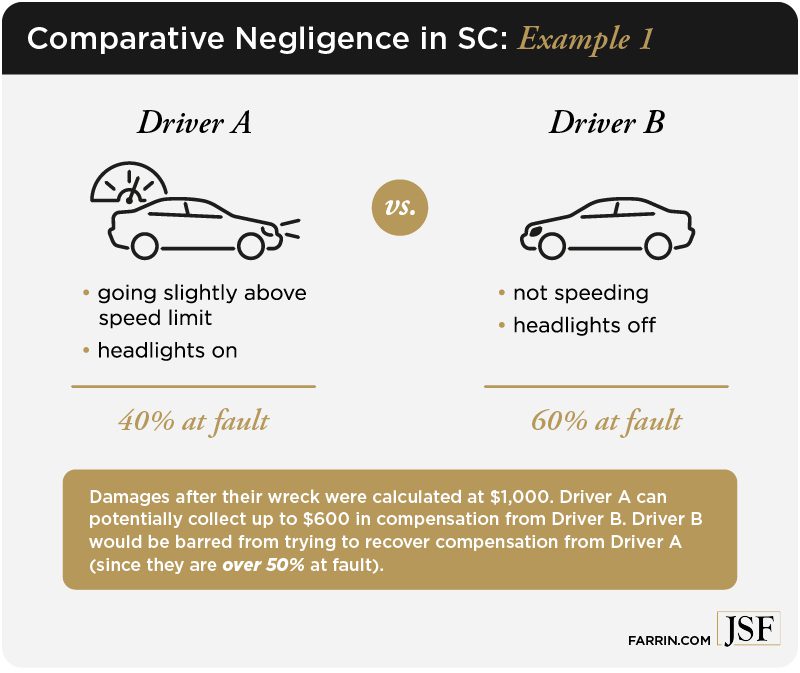Understanding Comparative Negligence in Car Accident Cases is crucial for anyone involved in a car accident. This legal principle significantly impacts the outcome of personal injury claims, determining how responsibility for the accident is divided between the parties involved and consequently, the amount of compensation awarded. This exploration will delve into the intricacies of comparative negligence, examining its various forms, the process of assigning fault, and its ultimate effect on damage awards.
We will also look at how insurance companies factor comparative negligence into their claims processes.
The system of comparative negligence, unlike its stricter counterpart, contributory negligence, allows for a more nuanced approach to accident liability. Instead of completely barring a plaintiff from recovery if they bear any fault, comparative negligence allows for partial recovery, proportional to the degree of the defendant’s negligence. This nuanced approach offers a fairer resolution in many car accident cases, but understanding its complexities is essential for both accident victims and those potentially facing liability.
Introduction to Comparative Negligence
Comparative negligence is a legal doctrine that assigns fault for an accident to all parties involved, based on their respective degrees of negligence. This contrasts sharply with contributory negligence, where any fault on the part of the plaintiff bars recovery, regardless of the defendant’s degree of fault. Understanding comparative negligence is crucial for anyone involved in a car accident, as it directly impacts the amount of compensation a plaintiff can receive.
The Concept of Comparative Negligence in Car Accidents
In a car accident case applying comparative negligence, the court or jury determines the percentage of fault attributable to each party involved. This percentage directly affects the amount of damages each party can recover. For example, if a plaintiff is found 20% at fault and the defendant 80% at fault, the plaintiff’s recovery will be reduced by 20%.
Comparative Negligence vs. Contributory Negligence
The key difference lies in the impact of the plaintiff’s negligence. Under contributory negligence, any negligence on the plaintiff’s part completely bars recovery. In contrast, comparative negligence allows for recovery even if the plaintiff is partially at fault; the recovery is simply reduced proportionally to their degree of fault.
Examples of Comparative Negligence in Car Accidents
Several scenarios illustrate the application of comparative negligence. For example, if a driver runs a red light and collides with another driver who was speeding, both drivers may be found partially at fault. Similarly, if a driver fails to yield the right-of-way and another driver fails to brake appropriately, both could share responsibility for the accident. Another example involves a driver who is distracted by their phone and hits a pedestrian who was jaywalking.
Types of Comparative Negligence Systems, Understanding Comparative Negligence in Car Accident Cases
| Type | Description | Example |
|---|---|---|
| Pure Comparative Negligence | Plaintiff can recover damages even if they are more than 50% at fault. Their recovery is reduced by their percentage of fault. | Plaintiff 70% at fault, Defendant 30% at fault; Plaintiff recovers 30% of damages. |
| Modified Comparative Negligence (50% Rule) | Plaintiff can recover damages only if their fault is less than 50%. | Plaintiff 49% at fault, Defendant 51% at fault; Plaintiff recovers a portion of damages. Plaintiff 51% at fault, Defendant 49% at fault; Plaintiff recovers nothing. |
| Modified Comparative Negligence (51% Rule) | Plaintiff can recover damages only if their fault is less than or equal to 50%. | Plaintiff 50% at fault, Defendant 50% at fault; Plaintiff recovers a portion of damages. Plaintiff 51% at fault, Defendant 49% at fault; Plaintiff recovers nothing. |
Determining Percentage of Fault
Assigning fault percentages requires careful consideration of various factors and a thorough review of evidence. The process often involves expert witness testimony, analysis of physical evidence, and interpretation of applicable traffic laws.
Factors Considered in Assigning Fault Percentages
Several factors are considered, including the speed of vehicles, whether traffic signals were obeyed, road conditions, visibility, driver impairment (due to alcohol or drugs), and any pre-existing mechanical failures. Each jurisdiction may have its own nuances in how these factors are weighted.
Using Evidence to Determine Fault
Evidence such as witness testimonies, police reports, accident reconstruction reports, dashcam footage, and photos of the accident scene all play a crucial role. The credibility and reliability of this evidence are carefully evaluated by the court or jury.
Jurisdictional Differences in Fault Apportionment
Different jurisdictions may have different approaches to assigning fault. Some may favor a more proportional approach, while others might give greater weight to certain factors over others. For example, one state might place more emphasis on traffic violations, while another might focus more on the overall circumstances of the accident.
Hypothetical Scenario and Fault Determination
Let’s consider a scenario where Driver A runs a red light and collides with Driver B, who was speeding. Driver A’s actions were clearly negligent, but Driver B’s speeding also contributed to the accident. A court might assign 70% fault to Driver A and 30% to Driver B, based on the severity of their respective actions and the overall circumstances.
Impact on Damages Awarded
Comparative negligence significantly impacts the amount of damages awarded to a plaintiff. The plaintiff’s recovery is reduced proportionally to their percentage of fault. This applies to both economic and non-economic damages.
How Comparative Negligence Reduces Recovery

If a plaintiff is found 30% at fault, their recovery will be reduced by 30%. This means that if they were awarded $100,000 in damages, they would only receive $70,000 after the reduction for their comparative negligence.
Impact on Economic and Non-Economic Damages
Comparative negligence affects all types of damages. Economic damages (medical bills, lost wages) and non-economic damages (pain and suffering, emotional distress) are both subject to reduction based on the plaintiff’s percentage of fault.
Scenarios and Impact on Damage Awards

| Plaintiff’s Fault (%) | Defendant’s Fault (%) | Total Damages | Plaintiff’s Recovery |
|---|---|---|---|
| 10 | 90 | $100,000 | $90,000 |
| 30 | 70 | $100,000 | $70,000 |
| 50 | 50 | $100,000 | $50,000 (under a pure comparative negligence system) or $0 (under a 51% rule modified system) |
Defenses Against Comparative Negligence Claims
Defendants in comparative negligence cases often employ various defenses to reduce their liability. These defenses aim to either minimize their own percentage of fault or highlight the plaintiff’s significant contribution to the accident.
Common Defenses in Comparative Negligence Cases
Common defenses include arguing that the plaintiff’s actions were the sole cause of the accident, that the plaintiff failed to mitigate their damages, or that the plaintiff assumed the risk. Defendants may also argue that the plaintiff’s negligence exceeded the threshold for recovery under a modified comparative negligence system.
Presentation and Argument of Defenses in Court
These defenses are presented through evidence such as witness testimonies, expert opinions, and physical evidence. Attorneys build their arguments around demonstrating the plaintiff’s negligence and minimizing their client’s role in the accident.
Comparison of Different Defense Strategies
The effectiveness of each defense strategy depends heavily on the specific facts of the case and the jurisdiction’s laws. Some jurisdictions might be more receptive to certain defenses than others. A strong defense will involve a comprehensive analysis of the accident and a persuasive presentation of evidence to the court.
Examples of Successful and Unsuccessful Defenses
A successful defense might involve proving that the plaintiff was solely responsible for the accident. An unsuccessful defense might be one where the defendant’s negligence is overwhelmingly evident, regardless of the plaintiff’s actions.
Specific Scenarios and Case Studies: Understanding Comparative Negligence In Car Accident Cases
Analyzing specific scenarios and case studies helps illustrate the complexities and practical applications of comparative negligence in car accident cases.
Case Study: A Comparative Negligence Car Accident

In a hypothetical case, Driver X failed to stop at a stop sign and collided with Driver Y, who was speeding. The court found Driver X 60% at fault and Driver Y 40% at fault, based on the evidence presented. Driver Y’s speeding contributed to the severity of the accident, but Driver X’s failure to stop at the stop sign was the primary cause.
Multi-Vehicle Accident Scenario
Imagine a three-car pile-up. Driver A rear-ended Driver B, who then collided with Driver C. The court might apportion fault based on the contributing factors of each driver: Driver A’s inattentive driving, Driver B’s following distance, and Driver C’s unexpected braking.
Jurisdictional Differences in Handling the Same Accident
The same accident scenario could lead to different fault apportionments depending on the jurisdiction. A state with a pure comparative negligence system might allow recovery even if the plaintiff is mostly at fault, whereas a state with a modified comparative negligence system might bar recovery if the plaintiff’s fault exceeds a certain threshold.
Car Accident Involving a Pedestrian
If a driver hits a pedestrian who was jaywalking, the court would consider both the driver’s failure to maintain a proper lookout and the pedestrian’s disregard for traffic laws. The apportionment of fault would depend on the specific circumstances, such as the visibility, speed, and actions of both parties.
The Role of Insurance Companies
Insurance companies play a significant role in handling claims involving comparative negligence. The percentage of fault assigned to each party directly impacts the insurance payout.
Handling Claims Involving Comparative Negligence
Insurance companies investigate accidents, assess liability, and determine the appropriate level of compensation based on the applicable comparative negligence rules and the policy coverage.
Impact on Insurance Policy Coverage
Comparative negligence affects the amount an insurance company will pay out. If a policyholder is found partially at fault, their recovery will be reduced accordingly, and the insurance company will only pay for the portion of the damages they are responsible for.
Impact of Fault Percentage on Insurance Payout
The percentage of fault directly correlates to the insurance payout. A higher percentage of fault results in a lower payout. For example, if a policyholder is 20% at fault, their insurance company will pay 80% of the damages, assuming sufficient coverage.
Example of Insurance Claim Adjustment
If a policyholder is found 40% at fault in an accident resulting in $50,000 in damages, their insurance company will only pay $30,000 ($50,000 x 0.60) assuming their policy covers the damages.
In conclusion, navigating the complexities of comparative negligence in car accident cases requires a thorough understanding of the legal framework governing fault apportionment and its impact on damage awards. From determining fault percentages based on available evidence to understanding the various types of comparative negligence systems and their implications, the process is multifaceted. Seeking legal counsel is highly recommended to ensure your rights are protected and your claim is handled effectively.
By carefully considering all aspects of comparative negligence, individuals can better protect themselves and pursue just compensation in the event of a car accident.
FAQ Corner
What is the difference between pure and modified comparative negligence?
In pure comparative negligence, a plaintiff can recover damages even if they are more at fault than the defendant. Modified comparative negligence, however, bars recovery if the plaintiff’s negligence exceeds a certain threshold (often 50%).
Can I still sue if I’m partially at fault for a car accident?
Yes, under comparative negligence, you can still sue, but your damages will be reduced proportionally to your degree of fault.
How is fault determined in a car accident case?
Fault is determined through evidence such as police reports, witness testimonies, expert opinions, and physical evidence from the accident scene.
What types of damages are affected by comparative negligence?
Both economic damages (medical bills, lost wages) and non-economic damages (pain and suffering) are subject to reduction based on comparative negligence.


